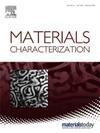添加 Er 后 AlCuMgSi(Sc)合金的多重析出和长期稳定性得到增强
IF 4.8
2区 材料科学
Q1 MATERIALS SCIENCE, CHARACTERIZATION & TESTING
引用次数: 0
摘要
有意研究了添加 Er 的 AlCuMgSiSc 合金的析出物演化和微观结构稳定性。结果表明,AlCuMgSiErSc 合金在时效 12 h 后,通过沉淀强化,促进了含铜析出物(棒状嗜Q′和板状嗜L析出物)的生成,并获得了最高的抗拉强度∼441.3 MPa。同时,AlCuMgSiErSc 合金在严重超时效 150 h 后,其 UTS(27.7 MPa)和 YS(34.1 MPa)分别比 AlCuMgSiSc 合金高出约 ∼ 6.9 % 和 ∼ 10.8 %。令人惊讶的是,在 AlCuMgSiErSc 合金中很少观察到 σ-Al5Cu6Mg2 沉淀,这表明 σ-Al5Cu6Mg2 的形成受到了抑制。具有混合结构的 Q′析出物和 L 析出物的高密度可以解释出色的热稳定性。此外,Er 溶质原子优先偏析于 Q′沉淀的界面并富集到 θ' 沉淀中,从而抑制了溶质原子的扩散并稳定了沉淀的粗化。这项研究为设计具有热稳定微观结构的 AlCu 系列合金提供了一种策略。本文章由计算机程序翻译,如有差异,请以英文原文为准。
Enhanced multiple precipitation and long-term stability in AlCuMgSi(Sc) alloys with Er additions
The precipitate evolution and microstructure stability of AlCuMgSiSc alloys with Er additions were intentionally investigated. It reveals that the Cu-containing metastable precipitates (rod-liked Q′ and lath-liked L precipitates) are promoted and achieved highest tensile strength of ∼441.3 MPa through precipitation strengthening after aging at 12 h in AlCuMgSiErSc alloy. Meanwhile, the AlCuMgSiErSc alloy shows approximately ∼6.9 % and ∼ 10.8 % higher UTS (27.7 MPa) and YS (34.1 MPa) than AlCuMgSiSc alloy after severe over aging for 150 h, respectively. Surprisingly, the σ-Al5Cu6Mg2 precipitates are rarely observed in AlCuMgSiErSc alloy indicating that the formation of σ-Al5Cu6Mg2 is inhibited. The excellent thermal stability can be explained by the high density of Q′ precipitates with hybrid structures and L precipitates. Moreover, Er solute atoms preferentially segregate at the interface of the Q′ precipitates and enrich the θ' precipitate, which inhibits the diffusion of solute atoms and stabilizes the coarsening of precipitates. This work may provide a strategy for designing Al![]() Cu series alloys with thermally stable microstructures.
Cu series alloys with thermally stable microstructures.
求助全文
通过发布文献求助,成功后即可免费获取论文全文。
去求助
来源期刊

Materials Characterization
工程技术-材料科学:表征与测试
CiteScore
7.60
自引率
8.50%
发文量
746
审稿时长
36 days
期刊介绍:
Materials Characterization features original articles and state-of-the-art reviews on theoretical and practical aspects of the structure and behaviour of materials.
The Journal focuses on all characterization techniques, including all forms of microscopy (light, electron, acoustic, etc.,) and analysis (especially microanalysis and surface analytical techniques). Developments in both this wide range of techniques and their application to the quantification of the microstructure of materials are essential facets of the Journal.
The Journal provides the Materials Scientist/Engineer with up-to-date information on many types of materials with an underlying theme of explaining the behavior of materials using novel approaches. Materials covered by the journal include:
Metals & Alloys
Ceramics
Nanomaterials
Biomedical materials
Optical materials
Composites
Natural Materials.
 求助内容:
求助内容: 应助结果提醒方式:
应助结果提醒方式:


